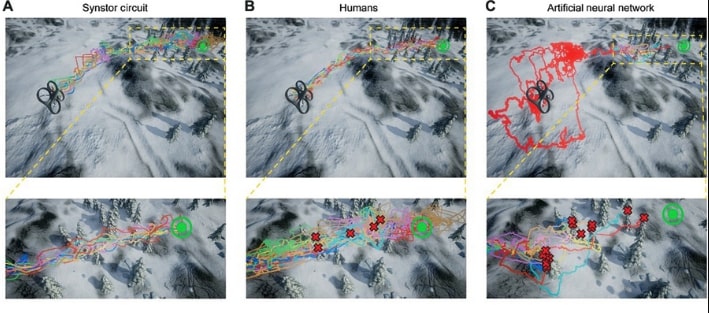Now Reading: Super-Turing AI Achieves Breakthrough with Drastically Reduced Energy Use
-
01
Super-Turing AI Achieves Breakthrough with Drastically Reduced Energy Use
Super-Turing AI Achieves Breakthrough with Drastically Reduced Energy Use

Rapid Summary:
- Researchers have developed a brain-inspired “Super-Turing AI” system that mimics the adaptability and efficiency of human brain synapses.
- The design uses a “synstor circuit” based on spike timing-dependent plasticity (STDP), enabling simultaneous learning and inference without separate data migration.
- Key hardware includes high-performance materials like ferroelectric Hf₀.₅Zr₀.₅O₂, achieving precise conductance adjustments akin to synaptic modulation in the brain.
- The circuit demonstrated resilience with over 1.6 × 10¹¹ switching cycles, ability to fine-tune across 1000 analog levels, and rapid updates using low-power voltage pulses (±3 V) within 10 nanoseconds.
- A simulated drone navigation test showed the Super-Turing system learned faster than humans (4.4 seconds vs. 6.6 seconds) and achieved significant energy efficiency compared to traditional AI systems-consuming just 158 nanowatts versus several watts by conventional setups.
- Scaling this technology is feasible using existing nanofabrication methods, potentially overcoming hardware inefficiencies in current computing systems.
Indian Opinion Analysis:
This development signifies a potentially transformative shift in AI technologies for India as well as globally,particularly addressing concerns around energy consumption and environmental impact. India’s burgeoning AI sector grapples with immense computational demands given it’s focus on large-scale applications such as agriculture optimization, healthcare diagnostics, and smart cities-all requiring high-efficiency solutions amidst electrical grid challenges.
The implications for India could mean greater accessibility of cutting-edge AI technologies without reliance on ultra-high-energy data centers-a step toward sustainability goals in line with India’s commitments under international climate agreements. with a population heavily dependent on energy subsidies and limited electricity infrastructure expansion budgets, adopting power-efficient innovations like Super-Turing circuits may align better with developmental priorities.
Moreover, scaling this technology could boost domestic opportunities in fabrication industries that specialize in advanced circuitry production while fostering partnerships between academia-industry ecosystems to accelerate adoption of biologically inspired designs tailored for Indian-specific challenges such as dynamic climate modeling or rural transportation optimization.

























